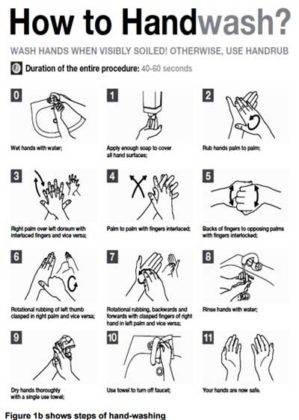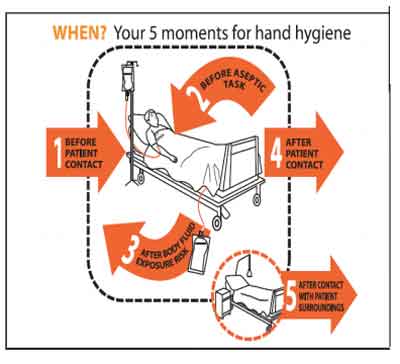- Home
- Editorial
- News
- Practice Guidelines
- Anesthesiology Guidelines
- Cancer Guidelines
- Cardiac Sciences Guidelines
- Critical Care Guidelines
- Dentistry Guidelines
- Dermatology Guidelines
- Diabetes and Endo Guidelines
- Diagnostics Guidelines
- ENT Guidelines
- Featured Practice Guidelines
- Gastroenterology Guidelines
- Geriatrics Guidelines
- Medicine Guidelines
- Nephrology Guidelines
- Neurosciences Guidelines
- Obs and Gynae Guidelines
- Ophthalmology Guidelines
- Orthopaedics Guidelines
- Paediatrics Guidelines
- Psychiatry Guidelines
- Pulmonology Guidelines
- Radiology Guidelines
- Surgery Guidelines
- Urology Guidelines
GOI guidelines on hand washing and Surgical Hand Scrub- Read the details
Pathogenic organisms from colonized and infected patients (and sometimes from the environment) transiently contaminate the hands of staff during normal clinical activities and can then be transferred to other patients. Hand transmission is one of the most important methods of spread of infectious agents in health care facilities. Proper hand hygiene is an effective method for preventing the transfer of microbes between staff and patients. Increasing hand-washing compliance by 1.5 – 2 folds would result in a 25-50-% decrease in the incidence of healthcare associated infection
National Centre for Disease Control, MOHFW, Government of India, in their Hospital infection control and prevention guidelines cleary provide guidelines for maintaining proper hand hygiene in a hospital setup. Its important that all these are adopted by all healthcare as well as allied professionals in their daily practise.
Following are the major recommendations:-
Wash hands with plain or antimicrobial soap and water or rub hands with an alcohol-based formulation before handling medication or preparing food (steps shown in figure1 a, b)
Hand hygiene must be practiced (Figure 2) –
Surgical hand scrub with medicated soap or surgical handrub with alcohol-based formulations - Either method is suitable for the prevention of surgical site infection. The combined effect – rapid action at the beginning and inhibition of regrowth of bacteria under the gloved hands – is best achieved by using an alcohol-based compound containing chlorhexidine, or with the addition of a quaternary ammonium compound such as mecetronium sulfate.
Steps before starting surgical hand preparation -
Training and compliance for hand-hygiene needs to be monitored. Availability of hand rubs, Soaps hand towels and water should be ensured. Foot operated and wall mounted dispensing stations are required. Hand hygiene training programme for doctors, nursing staff, and housekeeping staff needs to be done regularly for each category of staff. Hand hygiene compliance need to be monitored.
National Centre for Disease Control, MOHFW, Government of India, in their Hospital infection control and prevention guidelines cleary provide guidelines for maintaining proper hand hygiene in a hospital setup. Its important that all these are adopted by all healthcare as well as allied professionals in their daily practise.
Following are the major recommendations:-
Wash hands with plain or antimicrobial soap and water or rub hands with an alcohol-based formulation before handling medication or preparing food (steps shown in figure1 a, b)
Five (5) Moments in Hand Hygiene
Hand hygiene must be practiced (Figure 2) –
- Before touching a patient.
- Immediately before performing a clean or aseptic procedure,including handling an invasive device for patient care, regardless of whether or not gloves are used.
- Promptly after contact with body fluids, excretions, mucous membranes, non-intact skin, or wound dressings regardless of whether or not gloves were used.
- After touching a patient and his/her immediate surroundings, even when leaving the patient's side.
- After contact with inanimate objects (including medical equipment and furniture) in the immediate vicinity of the patient.Perform hand wash when hands are visibly dirty.
Surgical Hand Scrub
Surgical hand scrub with medicated soap or surgical handrub with alcohol-based formulations - Either method is suitable for the prevention of surgical site infection. The combined effect – rapid action at the beginning and inhibition of regrowth of bacteria under the gloved hands – is best achieved by using an alcohol-based compound containing chlorhexidine, or with the addition of a quaternary ammonium compound such as mecetronium sulfate.
STEPS FOR SURGICAL HAND PREPARATION
Steps before starting surgical hand preparation -
- Keep nails short and pay attention to them when washingyour hands – most microbes on hands come from beneath the fingernails.
- Do not wear artificial nails or nail polish.
- Remove all jewellery (rings, watches, bracelets) before entering the operating room suite.
- Wash hands and arms up to elbows with a non-medicated soap before entering the operating room area or if hands are visibly soiled.
- Clean subungual areas with a nail file. Nailbrushes should not be used as they may damage the skin and encourage shedding of cells. Nailbrushes, if used, must be sterile and used only once. Reusable autoclavable nail brushes are available commercially.
Protocol for surgical scrub with a medicated soap
- Start timing. Scrub each side of each finger, between the fingers, and the back and front of the hand for two minutes.
- Proceed to scrub the arms, keeping the hand higher than the arm at all times. This helps to avoid recontamination of the hands by water from the elbows and prevents bacteria-laden soap and water from contaminating the hands.
- Wash each side of the arm from wrist to the elbow for one minute
- Repeat the process on the other hand and arm, keeping hands above elbows at all times. If the hand touches anything except the brush at any time, the scrub must be lengthened by one minute for the area that has been contaminated.
- Rinse hands and arms by passing them through the water in one direction only, from fingertips to elbow. Do not move the arm back and forth through the water.
- Proceed to the operating room suite holding hands above elbows.
- At all times during the scrub procedure, care should be taken not to splash water onto surgical attire.
- Once in the operating room suite, hands and arms should be dried using a sterile towel and aseptic technique before putting on gown and gloves.
Protocol for surgical scrub with an alcohol-based preparation
- Start timing. Use sufficient product to keep hands and forearms wet with the handrub throughout the procedure.
- After application of the alcohol-based product, allow hands and forearms to dry thoroughly before donning sterile gloves.
- Proceed to the operating room suite holding hands above elbows.
- If hands are visibly soiled, wash hands with plain soap before surgical hand scrub.
Training and compliance for hand-hygiene needs to be monitored. Availability of hand rubs, Soaps hand towels and water should be ensured. Foot operated and wall mounted dispensing stations are required. Hand hygiene training programme for doctors, nursing staff, and housekeeping staff needs to be done regularly for each category of staff. Hand hygiene compliance need to be monitored.
Next Story
NO DATA FOUND



Disclaimer: This site is primarily intended for healthcare professionals. Any content/information on this website does not replace the advice of medical and/or health professionals and should not be construed as medical/diagnostic advice/endorsement or prescription. Use of this site is subject to our terms of use, privacy policy, advertisement policy. © 2020 Minerva Medical Treatment Pvt Ltd